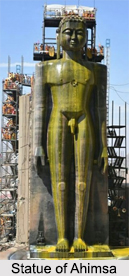 Depicting the first Jain Tirthankara, Rishabhanatha, the Statue of Ahimsa at Mangi-Tungi near Nashik in the Indian state of Maharashtra is the tallest Jain statue in the world. The statue stands tall at an elevation of 108 ft and is 121 ft including the pedestal.
Depicting the first Jain Tirthankara, Rishabhanatha, the Statue of Ahimsa at Mangi-Tungi near Nashik in the Indian state of Maharashtra is the tallest Jain statue in the world. The statue stands tall at an elevation of 108 ft and is 121 ft including the pedestal.
History of Statue of Ahimsa
In 1996, Jain aryika Gyanmati Mataji came up with the inspiration for the Statue of Ahimsa and in 2002 the Shilpapujan was done. For the construction of the statue more than 10,000 truck load of rock materials were required. The statue is located near the Mangi Tungi hills, which are considered to be one of the 4 siddha kshetras or pilgrimage sites for the Jain community in Maharashtra. The others being in Gajpantha, Kunthalgiri and Muktagiri, these sites are important places for pilgrimage for the Jain community, especially the local population of Marathi Jains and Kannadiga Jains.
History suggests, these hills are considered to be sacred as about 99 crore Jain sages had attained salvation here. It is also said that there are several Jain temples at the pinnacles and the bases of the hills.
Description of Statue of Ahimsa
The Statue of Ahimsa is a single carved out rock of Lord Rishabhanatha with a total size of 1840 sq. ft and is located 4, 343 ft above the sea level. Based on the inspiration of Gyanmati Mataji and under the guidance of aryika Sri Chandanamati Mataji, the construction of the statue started in 2002 and was completed on 24th January, 2016.
The engineer of the statue was Shri C.R. Patil, who was an official certified by the Guinness Book of World Records for the world`s tallest Jain idol. The Statue of Ahimsa was sculpted by the Shri Moolchand Ramchand Nahata Firm. The rural development department, led by Minister Pankaja Munde, approved the initial funds of 18.5 crore for the civil work in the temple area, which spread over 100 acres.
Festivals for Statue of Ahimsa
After the completion of the statue, the Panch Kalyanak Pratishtha Mahotsav was held from 11th to 17th February, 2016 at Mangi Tungi. Evidently there was a rise in the number of devotees and the local administration took effective measures accordingly. More than 100 Jain sages and aryikas participated in the event along with about 5000 pilgrims.
The festivities were also attended by important political figures like the Bhartiya Janata Party president, Amit Shah, Maharashtra`s Chief Minister Devendra Fadnavis along with the Maharashtra`s Rural Development Minister Pankaja Munde.
After the Panch Kalyanak Pratishtha Mahotsav, the first Mahamastakabhishek of the statue was held on 18th February, 2016. The Panchamrit Abhishek was performed using milk, flowers, orange juice, sugarcane juice, water, saffron etc.




















